Many plaster casts and photographs of footprints have been examined in detail which were reportedly made by a species of bipedal primate, the sasquatch or bigfoot. They prove not to be simply enlarged human footprints but show several peculiarities. These include flat arches, a double ball, and enlarged heels. Examination of leverage mechanics of the human foot indicates that with excessive body weight certain modifications would be advantageous. The expected modifications are the same as those seen in the reputed sasquatch footprints.
Within the last century, several hundred people have reported sightings of gigantic man-like animals in the forests and mountains of the Pacific Northwest. Hundreds more have seen the huge footprints left by these hairy creatures. Possibly ten times as many people have seen these giant primates and their tracks without reporting anything to newsmen or law officers for fear of ridicule.
The animal in question is commonly called sasquatch — based on one Indian name for it — or “bigfoot” for obvious reasons. If this animal really exists, it would probably be man’s closest living relative and a a member of the zoological family Hominidae. It is not human, however, in any sense of the word; all reports agree on its lack of language, artifacts, and social organization.
While a few scientists take these reports seriously, the majority doubt that any such animal exists. Sightings are usually dismissed as being of standing bears, hallucinations, or fabrications; footprints are explained as those of bears or, if they are quite distinct, as deliberately planted hoaxes. Also, skeptics point out that no specimen, living or dead, is available for scientific examination — not even a single bone has been identified as belonging to this species.
Tangible evidence for this type of primate consists mainly of several photographs, two short movie strips, handprints (Krantz 1971), and the footprints themselves which have been measured, drawn, photographed, and cast in plaster. I will not attempt to review here all of the above evidence, but will confine this analysis primarily to what can be deduced from the recorded footprints. Other evidence will be used only to help establish the approximate body weight involved, since this is the major factor in understanding the design of foot suggested here.
There are many sources of information on sasquatch or bigfoot tracks, not all of them equally reliable. I have examined casts made from the footprints of 17 different individuals and photographs of tracks and casts of another 50. On one occasion I saw an actual footprint left in snow. It is possible that some of the photographs are of faked prints — people are known to have attempted this — but most of the material upon which my study is based is probably as authentic as any that exists.
Information on sasquatch body weight is more difficult to obtain. Most people who report seeing them are sure they are very heavy. Estimates range from approximately 300 pounts to half a ton or more, but these are usually made under trying circumstances and cannot be taken as very precise.
Equally vague are estimates based on depth of impression of footprints. A sasquatch foot has about three times the surface area of a typical man’s foot. One might assume that if the print is as deep as a man makes in the same ground, the sasquatch is three times as heavy. If the print is twice as deep, the body weight of six men is indicated. Normally when people compare their own footprints with those of a sasquatch, it is by daylight and often many days later than the original made at night. Changes in soil softness and compressibility make such conclusions only rough estimates.
There are at least three cases I know of in which more precise information is available. The first is the reported capture of a young specimen in 1884 near Yale, British Columbia, by a railroad crew (Green 1968, 1970; Sanderson 1961). The original newspaper account has recently been confirmed to me by the grandson of one of the men involved. The creature, which soon disappeared, reportedly stood 4 feet 7 inches tall and weighed 127 pounds — a very stocky body build.
Roger Patterson, who took a short movie of one walking in northern California, estimated its body weight at 500 pounds. Beview of this film shows the subject to have been just 7 feet tall. Patterson’s estimate can be taken seriously because of his long good look at the animal and on his ability to accurately guess human weights — he called my own 210 pounds exactly. The third case is quite unverified but fits well into the series. An experienced hunter and prospector in northeastern Washington claims to have shot and killed one. He told me it measured 8½ feet tall and weighed 850 pounds according to careful examination of the body. (Since he has produced no evidence to back up his story, it is assumed by some to have been fabricated.)
When plotted on a graph, these three height and weight figures closely fit a curve based on theoretical calculations. The volume (and weight) of an object does not increase in direct proportion with its linear dimension or height but with the cube of that dimension. Thus, if an animal’s body is made twice as tall, keeping the same shape. It will be eight times as heavy. On a lesser scale, if an animal’s height is increased by half, its weight increase will be 1½ cubed (1½ x 1½ x 1½) or 3.375 times as great.
Jim McLarin of Willow Creek, California, was the first to apply this principle to sasquatch dimensions by taking a base figure of 6 feet tall and 300 pounds body weight, and extending on this. A curve drawn from this base line gives 134 pounds instead of 127 at 4 feet 7 inches, 477 pounds instead of 500 at 7 feet, and 852 pounds instead of 850 at 8 feet 6 inches. All three instances fit the curve very closely (Fig. 1).
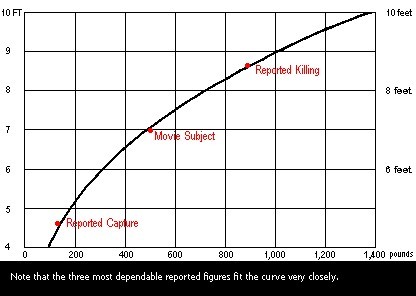
The vast majority of sasquatch heights are reported to be in the range of 7 to 9 feet tall. Body weights of 500 to 1,000 pounds are then the most reasonable expectations. Greater heights and weights have been claimed, and extending on this scale gives 1,389 pounds for 10 feet tall and 2,350 pounds for 12 feet tall, etc. I am inclined to set 9 feet and half a ton as the greatest size of bipedal primate that could properly function.
The typical sasquatch footprint looks superficially very much like a man’s increased to about 17 inches. Closer examination, however, shows several differences which have aroused some curiosity but little in the way of explanation until now. The key to figuring out the kind of foot involved lies in understanding how the indicated body weight would affect a gigantic, but otherwise normal, human foot. From this, one can go on to predict what kinds of modifications might reasonably be expected in such a foot in order to support a body of 500 to 1,000 pounds.
Increasing body size has an interesting effect on the strength of anatomical structures. The pulling power of muscles and the breaking strength of tendons and ligaments are directly proportional to their cross-sectional areas. Yet their weight, like that of the whole body, increases with volume. Cross-sectional areas increase with the square of a linear dimension, while weight increases with the cube. Thus if a man were doubled in height, keeping all proportions the same, his muscles and supporting tissues would be four times as strong, but his weight would become eight times greater. In relation to the weight he would have to maneuver, his strength would be cut in half. Some changes in body design, especially in lever lengths, would be desirable for such an enlarged man to move about like other people. The large size indicated for sasquatch poses the same kind of problem.
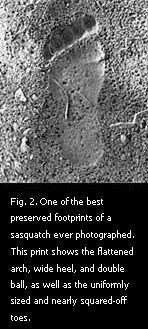 This print shows the flattened arch, wide heel, and double ball, as well as the uniformly sized and nearly squared-off toes.
This print shows the flattened arch, wide heel, and double ball, as well as the uniformly sized and nearly squared-off toes.The first peculiarity in these giant footprints is that they are quite flat. The instep or longitudinal arch of the foot is not there. In man this arch is maintained by ligaments and by the muscular pull on tendons. Given 500 pounds or more of body weight, these structures would not have sufficient increased strength and the arch would have to flatten. While adult sasquatch prints are flat, a number of supposed young ones show some arching. It is an interesting question whether the feet flatten with maturity just because of the weight, or if there are genetic mechanisms which would lead to a flat foot regardless of usage. If a number of people were making fake bigfoot prints, it might be expected that many of them would not have thought about this characteristic and would have included arches comparable to their own. None of the evidence I have examined shows a normal human arch.
Many sasquatch prints show what is called a double ball at the base of the big toe. Where the ball occurs in the human foot, there are often two distinct bulges, one behind the other (Fig. 2). The single bulge on the human foot is at the distal or forward end of the first metatarsal bone (see Fig. 3 for the bones of a normal human foot). The question then arises as to which of these two balls corresponds to the one of the human foot and what it is that the other one represents.
In his book, Ivan T. Sanderson (1961) suggested that the posterior ball is at the end of the metatarsal, and that the anterior ball is a pad of flesh under the first segment of a very long toe. Assuming all the toes are similarly long, it follows that they are webbed for a great part of their lengths. If these animals do a great deal of swimming as some people suspect, such toes would appear to make sense. However, this interpretation does not fit well with what is indicated of the creature’s weight.
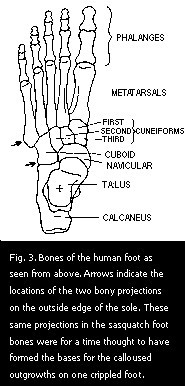 weight, but will push down only as a result of the pull of the tendons along their undersides. The muscular strength available to flex or curl such long toes would not be nearly enough to dig them into the ground as deeply as the rest of the foot. Long toes would bend upward with each deeply indented step, yet all footprints show well-indented toe impressions.
weight, but will push down only as a result of the pull of the tendons along their undersides. The muscular strength available to flex or curl such long toes would not be nearly enough to dig them into the ground as deeply as the rest of the foot. Long toes would bend upward with each deeply indented step, yet all footprints show well-indented toe impressions.Only a relatively short toe could have the proper tendon leverage to press firmly on the ground. Thus, it must be concluded that it is the anterior bulge that corresponds to the ball of the human foot, leaving relatively short, strong, and unwebbed toes. The posterior bulge remains to be explained. Given a totally flattened foot, all structures that would have constituted the arch will be firmly pressed to the ground. Behind the ball of the foot is the next bony projection, the near or proximal end of the first metatarsal (Fig. 3). If the posterior bulge is formed under the other end of this same bone, the two bulges would be much farther apart than is evident on any sasquatch footprint. The only way for the posterior bulge to be as far forward as it is, by this theory, is to assume that the metatarsal is abnormally short and the bones behind it abnormally long. An examination of the mechanics of walking will show that indeed this should be the case for a gigantic hominid.
The foot can be described as a simple lever at the end of the leg. In taking a step, muscles of the calf (gastrocnemius and soleus) tighten and pull up the projecting heel. With the foot pivoting at the ankle its forepart then presses downward, thus lifting the body in the basic “step-off” action. If the power arm of this lever (heel) is short and the load arm (forefoot) is long, a significant extension is added to each step. This is the normal human condition (Fig. 4).
If the body weight is increased many-fold and the strength of the calf muscles is increased to a much lesser degree, then this action is no longer possible in sustained walking. If his foot were built just like a man’s, the sasquatch would not have enough strength in his calf muscles to easily lift his vastly greater bulk with each step.
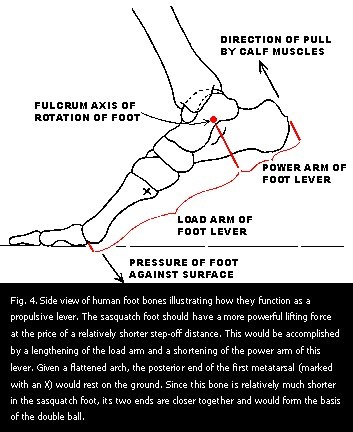 The simplest way to handle this problem is to change the lengths of the lever arms. If the heel, or power arm, is lengthened, greater force is applied to the step-off; if the forefoot, or load arm, is shortened, less force is required. Put another way, this adjustment means the ankle joint must be set relatively farther forward along the length of the foot.
The simplest way to handle this problem is to change the lengths of the lever arms. If the heel, or power arm, is lengthened, greater force is applied to the step-off; if the forefoot, or load arm, is shortened, less force is required. Put another way, this adjustment means the ankle joint must be set relatively farther forward along the length of the foot.
The metatarsals are the longest bones in the forefoot. If this region is to be relatively shortened, the base of the first metatarsal must be moved far forward. Given a sufficient shortening of this bone, its two ends will be in the proper positions to form the double ball as seen in many sasquatch footprints.
If the foot segments are altered in this way, the heel section must be correspondingly longer. This is difficult to measure in footprints, but in some cases it is clearly evident. Rather than being simply longer, the heel region is wider as well — typically one-third of the foot length. Such a general enlargement of the calcaneum (heel bone) should be expected for greater stability and to provide greater breaking strength in proportion to the increased strain put upon it.
The action described above is the step-off where the distal ends of all five metatarsals press against the ground when the heel is lifted. The “push-off” is still another matter where the toe segment is used to lengthen the stride with a final additional push. In man, it is only the big toe or first digit that is significantly involved in this final push-off. The action is not very powerful and many people do not use it at all. If a sasquatch were to try to use this final push-off from the big toe alone, he would not likely have sufficient strength to accomplish anything of the kind. Only by using all five toes in such an action might any possible push be given to his vast bulk.
A five-toed push-off would require at least two anatomical adjustments from the normal human condition which would be visible in footprints. Since the emphasis is not to be on the first toe alone, all five should be more nearly equal in size and strength. Also, in order for them to push in unison, the front of the foot should be more nearly squared-off instead of being strongly tapered as in man (Fig. 2).
Many sasquatch footprints show nearly equal-sized toes lined up almost straight across in a rather nonhuman manner as might be expected. Curiously, there are also several reported bigfoot prints which do not show much of those traits, but appear rather more human in the toes. There are two possible explanations for this. Sasquatch feet may include a great range of variation from a nearly human set of toes at one extreme to the ideal type described above at the other extreme. The second possibility is that some of these prints were faked, at least in part, by enlarging the impression of the first toe to make them look more “convincing.” I would rather not choose between these two alternatives at the present time.
In 1969 a number of sasquatch sightings were reported 100 miles north of Spokane, Washington, and late in that year several sets of tracks were seen and recorded by many observers. Casts were made from clear imprints of both feet of this individual and have been studied in great detail. This specimen is especially interesting because its right foot is deformed. The prints of each foot are about 17 inches long, indicating a fairly large creature perhaps in the 700 to 800 pound range (Fig. 5).
The right foot showed only four toes — the middle one was either missing or held vertically while the adjacent toes turned in, largely filling the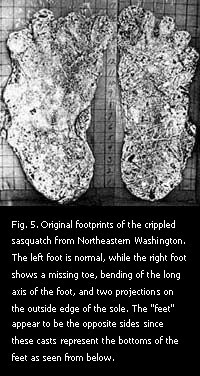 gap. More important was a distortion of the whole foot which was bent on its long axis. The origin of this deformity is not clear, but its effects illustrate something of the structure of the foot.
gap. More important was a distortion of the whole foot which was bent on its long axis. The origin of this deformity is not clear, but its effects illustrate something of the structure of the foot.
Taking the heel region as stationary, the entire forepart of the foot is turned inward about 30 degrees. The individual did not walk with the foot in this position, but turned it outward somewhat so that its toe-heel line was parallel to that of the other foot. This left both heel and toes twisted inward, while the weight of the leg rested more toward the outside edge of the foot. One effect of this displacement is a slight rise at the instep. This is the only case of an adult sasquatch footprint showing what might be called a raised arch.
Even more interesting is the outer edge of this foot where two lateral projections may be seen on the cast. Both feet appear to be strongly calloused around their edges and this callousing on the right foot extends around these two projections. At first glance these appear to correspond in location to normal bony projections. The anterior one would be the proximal or rear end of the fifth metatarsal. The posterior one would then be a projection on the rear edge of the cuboid bone. If these identifications were correct, the projections would be much farther forward than is normal for a human foot. This would mean the fifth metatarsal is abnormally short, and the calcaneus very large, just as indicated above from other evidence.
Actually the projections do not look like callouses over the bones indicated. The two projections are quite symmetrical and equal in size. Yet the two underlying bones, whether in man or gorilla, are not symmetrical, nor are they the same size. Therefore another interpretation is called for.
The twisting of this foot caused a compression of elements along the inside edge and an extension or spreading of all elements on the outside edge of the foot. Measuring around the outside curve from the base of the little toe to the heel tip, the right foot is almost two inches longer than the left. Unless some bones are enlarged, this means there must be open gaps between several of these bones. Since only three bones form this edge of the foot (fifth metatarsal, cuboid, and calcaneus), there are only two gaps that might have opened. These are in front of and behind the cuboid (Fig. 6).
Gaps between adjacent bones would have to be filled with cartilage or bony material in order to stabilize the foot. This filling would be expected to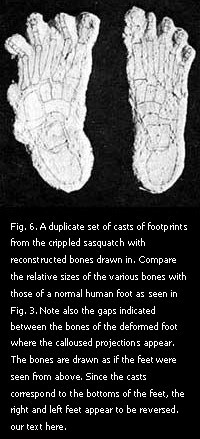 have grown outward beyond the bone gaps to form the bases upon which callouses developed.
have grown outward beyond the bone gaps to form the bases upon which callouses developed.
Projections of such gap-fillers would be located just behind the bony processes that were first considered. This means an even shorter fifth metatarsal and longer calcaneus than was previously indicated. It shows an excellent agreement with the short first metatarsal as was deduced from the double ball on the inside edge of the foot.
In general, the sasquatch foot differs from man’s in having greatly enlarged ankle bones, especially the heel, very short metatarsals, and a more nearly equal set of toes. These characteristics are all logical requirements for an otherwise human foot adapted to a body weight of 500 pounds or more. These characteristics are also evident in preserved footprints.
In addition, at least two eye-witnesses have added some confirmation to this reconstruction. Roger Patterson has told me his sasquatch appeared to have remarkably thick ankles, although this did not show clearly in his movie strip. If the leg is set relatively farther forward on the foot than in man, then a thick ankle is a consequence. The man who claims to have shot and killed a sasquatch in northeast Washington early in 1970 described the foot to me in some detail. He was most impressed by the relatively short and steeply sloped upper surface of the forefoot.
All good quality bigfoot prints must have been made by one or the other of two possible agencies. Either they are real footprints of a gigantic sub-human primate, or else they are faked as a hoax. (Only very vague prints could be confused with those of bears.)
There are a number of reasons to believe at least certain sasquatch tracks could not have been made by hoaxers. Their obscure locations would mean that perhaps a hundred times as many tracks were laid as have been discovered. Lengths of stride and obstacles stepped over often surpass anything a man can do. Depths of imprints would require a hoaxer to carry many hundreds of pounds of extra weight, thus making the walking accomplishments even more impossible. Independent toe movements as noticed in some tracks would require a special device to accomplish.
To all these must now be added the fact that our supposed hoaxer is an expert on human anatomy with a very inventive mind. He was able to create from nothing all the details of how a foot might be redesigned to support a body weight several times that of a man. And he has continued to plant these tracks over more than a lifetime, always showing only vague hints of these anatomical peculiarities. These include great width of heel, a double ball, and a straighter row of similarly sized toes.
No matter how incredible it may seem that the sasquatch exists and has remained uncaught, it is even more incredible to believe in all the attributes of the hypothetical human track-maker. As Sherlock Holmes put it, “… when you have eliminated the impossible, whatever remains, however improbable, must be the truth.” Even if none of the hundreds of sightings had ever occurred, we would still be forced to conclude that a giant bipedal primate does indeed inhabit the forests of the Pacific Northwest.
References Cited
- Green, John. 1968. On the Track of the Sasquatch. Agassiz, B.C.: Cheam Publishing.
- ——. 1970. Year of the Sasquatch. Agassiz, B.C.: Cheam Publishing.
- Krantz, Grover S. 1971. Sasquatch Handprints. Northwest Anthropological Research Notes, 5(2):145-151.
- Sanderson, Ivan T. 1961. Abominable Snowmen: Legend Come to Life. Philadelphia: Chilton Co.
From: Northwest Anthropological Research Notes 6(1) (Spring 1972).
